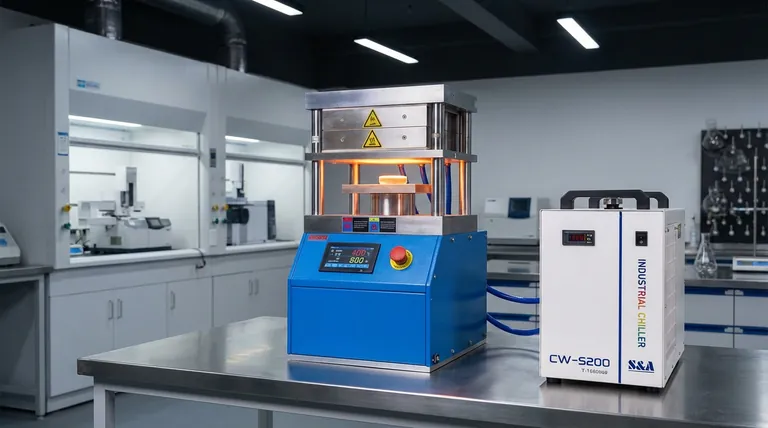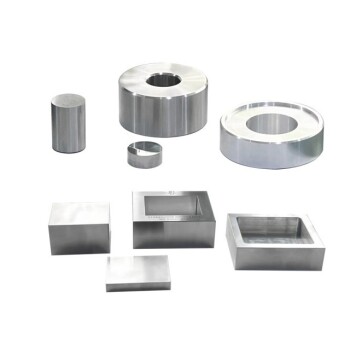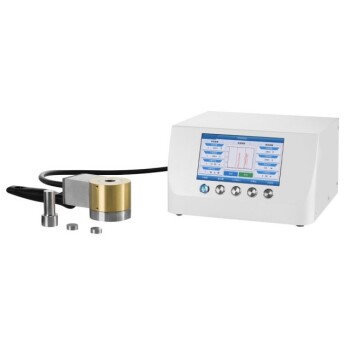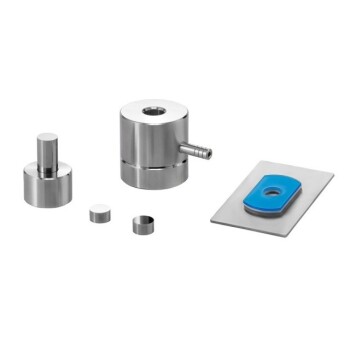At its core, a heated hydraulic press serves one primary function in spectroscopy: to transform a difficult-to-analyze sample into a uniform, solid disc that is ideal for analysis. The two main applications are the preparation of potassium bromide (KBr) pellets for Fourier Transform Infrared (FTIR) spectroscopy and the creation of pressed sample pellets for X-ray Fluorescence (XRF) spectroscopy. This process is essential for producing accurate, reproducible, and high-quality spectral data.
The fundamental purpose of using a press in spectroscopy is not merely to crush a sample, but to overcome physical barriers like light scattering and surface inconsistency. It creates a standardized, homogeneous medium, ensuring that the resulting spectrum accurately represents the sample's chemical makeup, not the randomness of its physical form.

The Role in FTIR Spectroscopy: Creating Optical Clarity
In FTIR analysis, an infrared beam must pass through a sample to measure which frequencies of light are absorbed. For solid samples, this presents a significant challenge.
The Problem: Light Scattering in Powders
A raw powder sample consists of countless tiny particles with air gaps between them. When an infrared beam hits this powder, the light scatters in all directions instead of passing through cleanly. This scattering effect severely degrades the quality of the spectrum, making it noisy and often un-interpretable.
The Solution: The KBr Pellet
The solution is to mix a very small amount of the sample powder (typically a 1:100 ratio) with a larger amount of an infrared-transparent salt, most commonly potassium bromide (KBr). KBr is used because it does not absorb light in the mid-infrared range, making it effectively invisible to the spectrometer.
Why Pressure is Critical
The hydraulic press applies immense, uniform pressure (often 8-10 tons) to this mixture inside a die set. This force causes the soft KBr salt to cold-flow and fuse together, eliminating the air gaps and trapping the sample particles within a solid, glass-like matrix. The result is a thin, transparent pellet that allows the IR beam to pass through with minimal scattering, producing a clean, high-resolution spectrum.
The Role in XRF Spectroscopy: Ensuring Surface Uniformity
XRF analysis works differently; it bombards the sample's surface with high-energy X-rays and measures the secondary "fluorescent" X-rays emitted back. Here, the quality of the surface is paramount.
The Problem: Inconsistent Density and Surface Effects
If you analyze a loose powder, the X-ray beam will interact with a non-uniform surface. Variations in particle size and packing density mean that the results can be inconsistent and non-reproducible. This is especially problematic for quantitative analysis, where the goal is to determine the precise concentration of each element.
The Solution: The Pressed Pellet
Using a hydraulic press to compact the sample powder into a solid, dense pellet creates a perfectly flat and homogeneous surface for analysis. This ensures that every measurement is taken on an identical surface, leading to highly reproducible and accurate elemental data.
The Role of Heat: Creating Fused Beads
For the absolute highest accuracy in XRF, a heated hydraulic press can be used. In this technique, the sample is mixed with a fluxing agent (like a lithium borate salt) and heated to over 1000°C to create a molten glass. This molten glass is then cooled into a perfectly homogeneous fused bead. This process completely eliminates any errors related to particle size or mineralogical structure, providing the gold standard for quantitative XRF analysis.
Understanding the Trade-offs and Considerations
While powerful, the pressing technique is not without its considerations. An expert analyst must be aware of potential pitfalls to ensure data integrity.
Risk of Pressure-Induced Changes
The immense pressure applied can sometimes alter the crystalline structure of a sample, a phenomenon known as polymorphism. This can cause shifts in an FTIR spectrum that are not representative of the original material.
Potential for Sample Contamination
The KBr or fluxing agent must be of the highest purity to avoid introducing contaminant peaks into the spectrum. Likewise, the die set used for pressing must be meticulously cleaned between samples to prevent cross-contamination.
The Impact of Heat
Using a heated press is ideal for creating ultra-homogeneous XRF samples, but it is not suitable for all materials. The high temperatures will cause thermal degradation in organic compounds or volatile substances, making it inappropriate for heat-sensitive samples.
Making the Right Choice for Your Goal
Proper sample preparation is the foundation of reliable spectroscopic data. Your choice of method should be dictated by your analytical goal and the nature of your sample.
- If your primary focus is identifying an organic compound (FTIR): Your goal is optical transparency, so creating a cold-pressed KBr pellet is the standard and most effective method.
- If your primary focus is rapid elemental screening (XRF): Creating a simple pressed powder pellet provides the surface uniformity needed for reliable, reproducible results.
- If your primary focus is high-accuracy quantitative elemental analysis (XRF): Creating a fused bead with a heated press will eliminate matrix effects and provide the most accurate data possible, provided your sample is thermally stable.
- If you are analyzing a pressure-sensitive or heat-sensitive material: Be aware of potential changes to your sample and consider alternative, non-destructive techniques (like Attenuated Total Reflectance FTIR) to validate your findings.
Ultimately, mastering the hydraulic press is about controlling the physical form of your sample so you can reveal its true chemical identity.
Summary Table:
| Application | Key Benefit | Common Use |
|---|---|---|
| FTIR Spectroscopy (KBr Pellets) | Reduces light scattering for clear IR transmission | Organic compound identification |
| XRF Spectroscopy (Pressed Pellets) | Ensures surface uniformity for reproducible results | Elemental screening and analysis |
| XRF Spectroscopy (Fused Beads) | Eliminates matrix effects for high accuracy | Quantitative elemental analysis |
Upgrade your lab's spectroscopy results with KINTEK's advanced lab press machines! Whether you need automatic lab presses, isostatic presses, or heated lab presses for precise sample preparation in FTIR or XRF, our equipment ensures uniform pellets and accurate data. Contact us today to learn how we can optimize your laboratory workflow and deliver reliable performance tailored to your needs.
Visual Guide

Related Products
- Automatic Heated Hydraulic Press Machine with Hot Plates for Laboratory
- Laboratory Hydraulic Press 2T Lab Pellet Press for KBR FTIR
- Automatic High Temperature Heated Hydraulic Press Machine with Heated Plates for Lab
- Automatic Heated Hydraulic Press Machine with Heated Plates for Laboratory
- Automatic Laboratory Hydraulic Press Lab Pellet Press Machine
People Also Ask
- What are the advantages of having a heating element in a hydraulic press? Unlock Precision in Material Processing
- How are heated hydraulic presses applied in the electronics and energy sectors? Unlock Precision Manufacturing for High-Tech Components
- What are the advantages of using a hydraulic heat press? Achieve Precision and Efficiency in Material Processing
- What are the applications of hydraulic heat presses in material testing and research? Enhance Precision and Reliability in Your Lab
- How is a hydraulic heat press used in laboratory sample preparation? Create Uniform Samples for Accurate Analysis



















